The Top 10 Biggest Spiders in the World
Key Points
- The giant huntsman spider only lives in caves in Laos, and it can have a leg span up to a horrifying twelve inches.
- The Amazon rainforest’s goliath bird-eating spider can have an eleven-inch leg span and weigh five or six ounces. It mainly eats insects, but can also prey on small birds.
- Brazilian Salmon Pink Birdeater Spider lives Brazil, Argentina, and Paraguay, with a ten-inch leg span.
If you are afraid of spiders, then you may be asking where the biggest spiders in the world live? The answer is that they live in many diverse locations. This list will tell you more about them, their size and where they live. The leg-span measurement at maturity has been used to determine the placings.
#10. Cerbalus aravaensis – 5.5-inch Leg Span
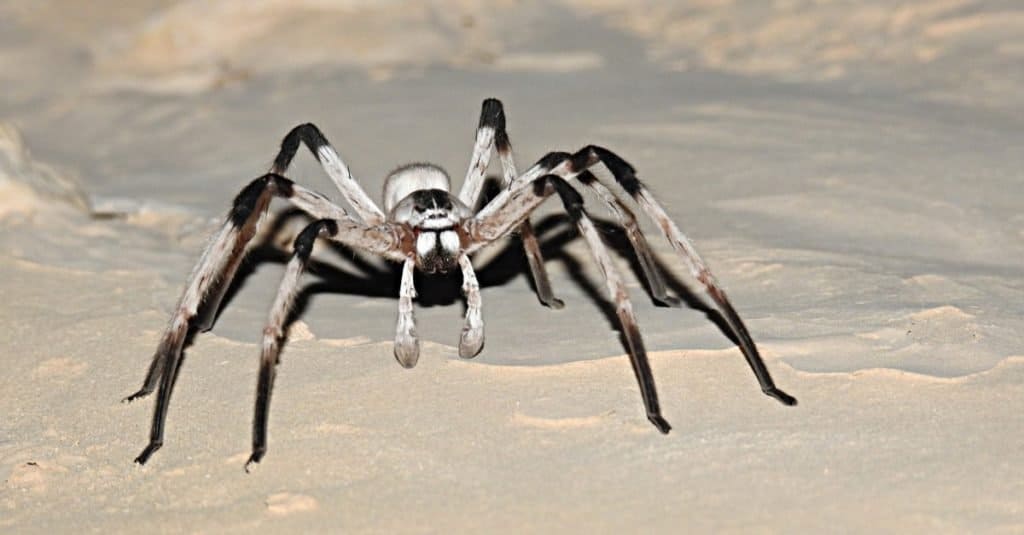
Dan Shachar/Shutterstock.com
If you travel to the sand dunes of the Arava Valley of Israel and Jordan, watch for the Cerbalus aravaensis spider. This spider is hard to miss because its 5.5-inch leg span makes it hard to miss an object crawling that is its size. Salt mining and agricultural land conversion threaten its habitat.
This nocturnal arthropod builds homes in the sand, where it hides from its predators. These homes have trap-like doors to protect these spiders that are some of the largest spiders in the world.
#9. Brazilian Wandering Spider – 5.9-inch Leg Span
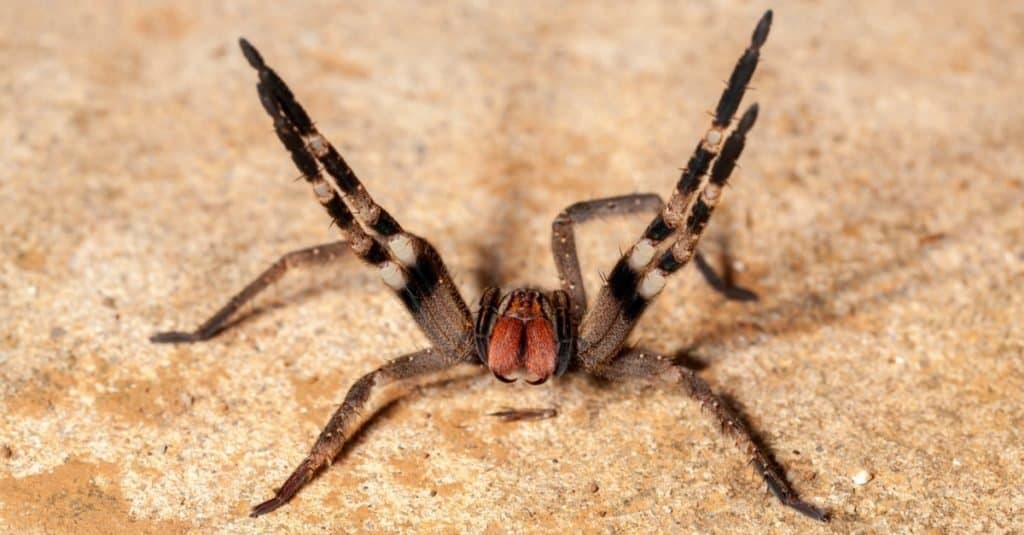
Tacio Philip Sansonovski/Shutterstock.com
The Brazilian wandering spider, also called the armed spiders or banana spiders, has a 5.9-inch leg span. The Guinness Book of World Records has classified this arthropod as one of the most venomous in the world. There are at least eight subspecies of this spider mainly lives in Brazil but also in Costa Rica to Argentina.
It is usually brown, and it may have a black spot on its belly. These are some of the largest hairy. The hairs often make the size of this option look even bigger. These nocturnal arthropods who live under logs dine on insects, small amphibians, reptiles, and mice.
#8. Camel Spider – 6-inch Leg Span
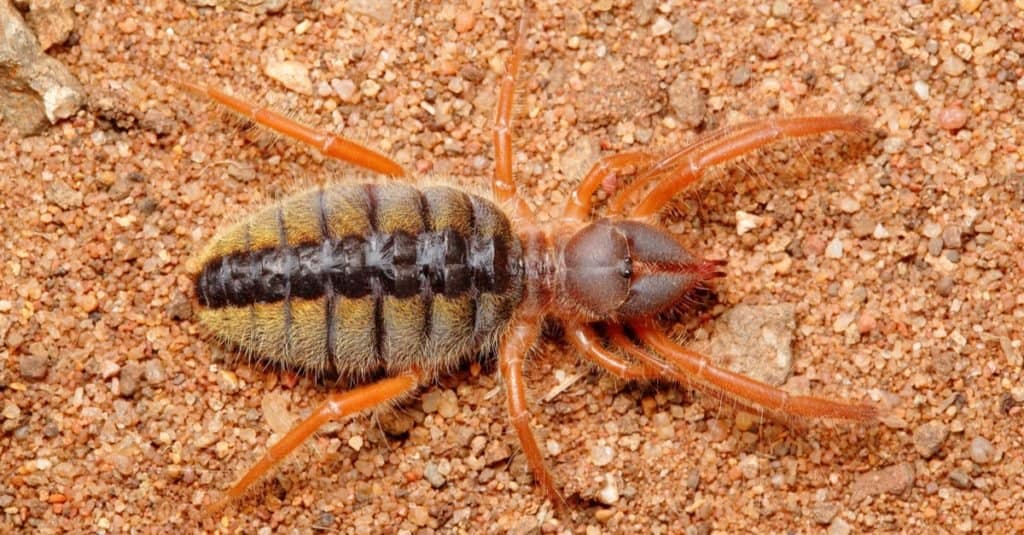
Ondrej Michalek/Shutterstock.com
The light tan camel spider has about a 6-inch leg span. It is one of the fastest spiders as it often moves at speeds approaching 10 miles per hour. These arthropods sometimes emit a buzzing sound, but they have no venom.
These spiders living in Iran and Iraq feast on insects, rodents, lizards, and small birds. The jaws on these spiders can make up to 33% of their total body length, and they use them to clamp down on their prey.
Learn more about camel spiders.
#7. Colombian Giant Redleg Tarantula – 7-inch Leg Span
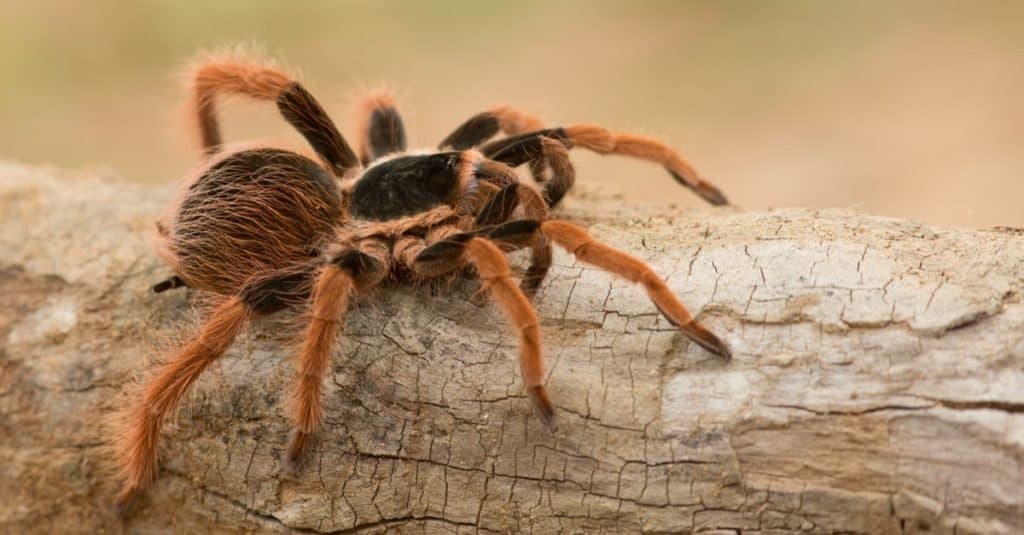
Milan Zygmunt/Shutterstock.com
The Columbian giant redleg spider has about a 7-inch leg span. This spider lives in Colombia and parts of Brazil. It has bright reddish-orange hairs on its legs. While males live to be about 4 years old, females often live to be 20 years old.
This nocturnal arthropod is very nervous. It will spin and start bobbing up and down. If the threat does not leave, it will use the hidden thorny spikes on its back legs in the direction of the danger. This spider will finally use its fangs to bite its victim.
#6. Hercules Baboon Spider – 7.9-inch Leg Span
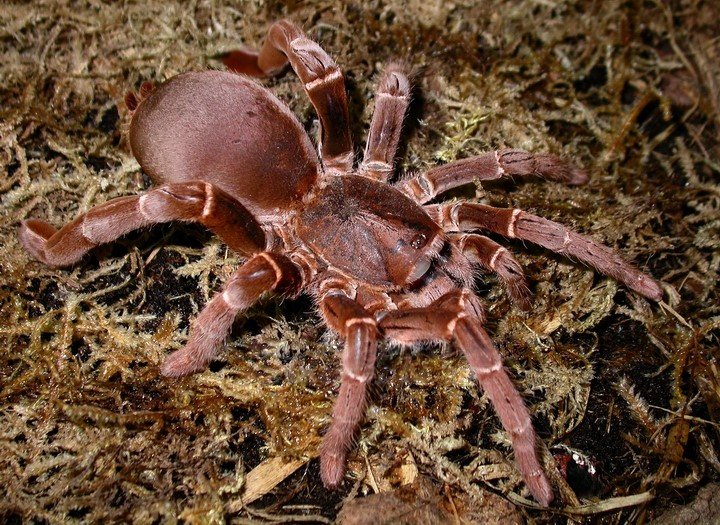
Www.universoaracnido.com / Creative Commons – License
Biologists have only found the Hercules baboon spider one time, but they collected it in Nigeria over 100 years ago. You can see it in London’s Natural History Museum. This East African arthropod takes its name from the fact that its rusty-brown body looks like a baboon. It may be the heaviest spider ever captured.
#5. Face-size Tarantula – 8-inch Leg Span
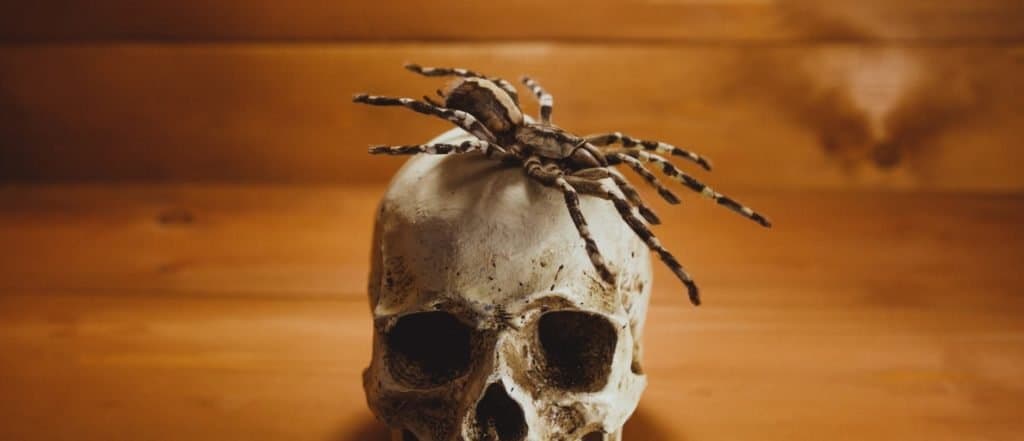
Anna55555/Shutterstock.com
The Face-size tarantula has about an 8-inch leg span. This spider found in Sri Lanka and India lives in old buildings and decaying wood. Its diet consists of birds, lizards, rodents, and snakes that are often bigger than this animal’s length.
This tarantula has daffodil-yellow banding on its legs and a pink band around its body. Scientists did not discover it until 2012, and biologists think there may be even more unknown arthropod species living in the northern area of Sri Lanka. Still, it is dangerous for them to explore there because of the ongoing conflict.
#4. Brazilian Giant Tawny Red Tarantula – 10-inch Leg Span
The Brazilian giant tawny red tarantula lives in Brazil, Uruguay, Paraguay, and Argentina. The fourth leg on this brown spider can be up to 2.3-inches long while its whole body is only 2.5 inches long.
#3. Brazilian Salmon Pink Birdeater Spider – 10-inch Leg Span
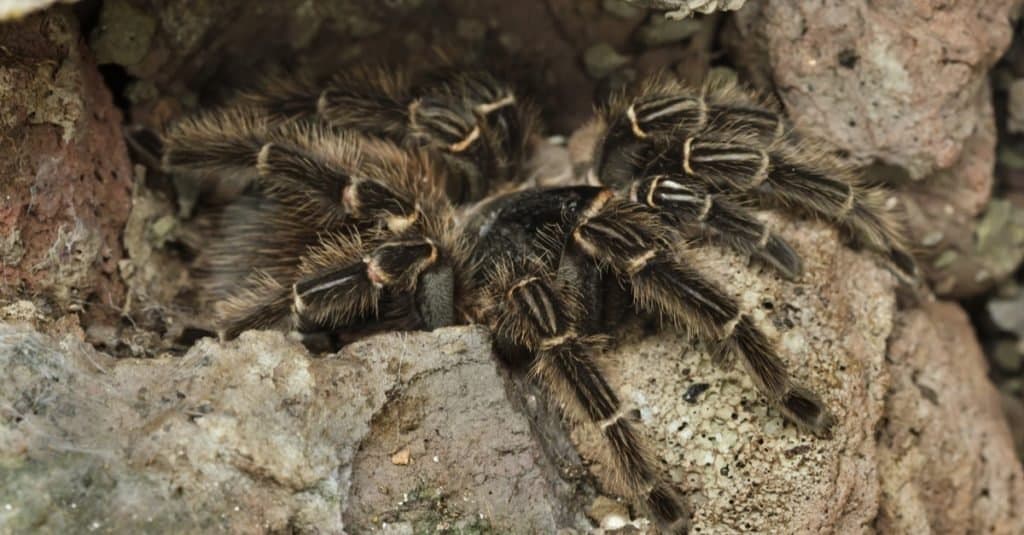
Vladimir Wrangel/Shutterstock.com
The Brazilian salmon pink birdeater spider has a 10-inch leg span. As the name suggests, this spider lives in Brazil, but you may also see it in Argentina and Paraguay. It has a dark brown body with bright salmon blotches on it making its length look even more intimidating.
First, this spider uses its fangs to inject venom into its prey. This venom kills the prey. Then, it releases fluid to digest the prey partially. While it is not listed as endangered, its Atlantic Forest habitat is constantly shrinking because of human developments.
#2. Goliath Bird Eating Spider – 11-inch Leg Span

juerginho/Shutterstock.com
The goliath bird-eating spider has an 11-inch leg span. Scientists discovered the first one in 1804. This brown-to-light-brown arthropod lives in Suriname, Guyana, French Guiana, Venezuela, and Brazil. This nocturnal arthropod lives mainly in the Amazon rainforest.
It weighs between 5 and 6 ounces. While people have observed a few of the largest ones eating small birds, like hummingbirds, most of their diet consists of insects and small terrestrial vertebrates. You will not usually see one dining because they drag their prey back to their hidden nests before eating.
#1. Giant Huntsman Spider – 12-inch Leg Span
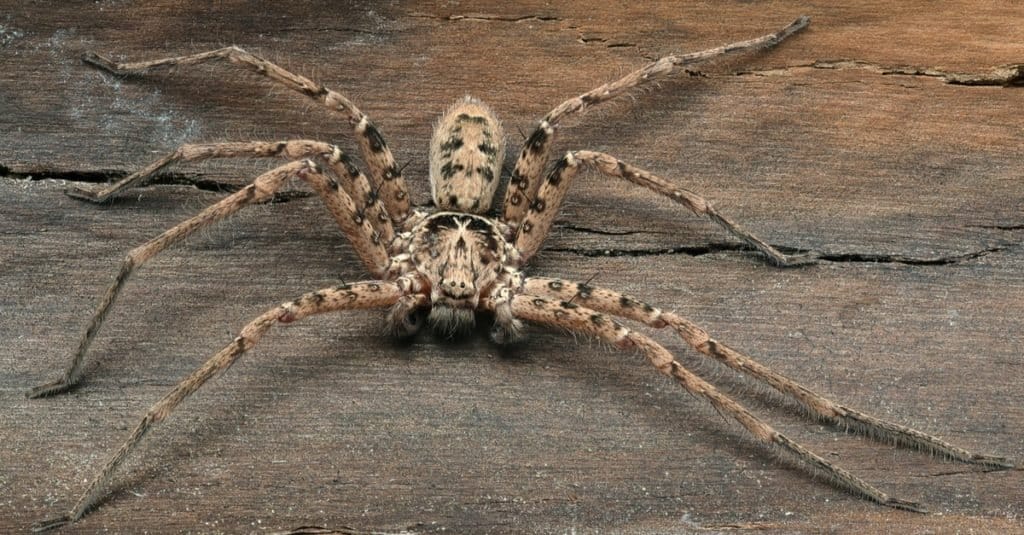
iSKYDANCER/Shutterstock.com
The biggest spider in the world is the giant huntsman spider as it has a leg span of 12 inches. It does not build a spiderweb to catch its prey. Instead, it hunts its prey down. While you can see huntsman spiders at many different worldwide locations, the giant huntsman arthropod only lives in caves in Laos. This arthropod discovered in 2001 has crablike legs with twisted joints, so they move like a crab.
This arthropod typically lives under decaying wood. When it spots its prey, it can move up to 3 feet in a second. These spiders have an elaborate mating ritual. Then, the female lays up to 200 eggs in a sack-like cocoon that she guards fiercely. After three weeks, when it is time for the spiderlings to hatch, she will help tear the cocoon open. She may stay with the spiderlings for several weeks.
Even if you are generally not afraid of spiders, these 10 are big enough to scare you. They are amazing arthropods that need you to help protect their habitat. Even though you probably don’t want any of these arachnids anywhere near you understandably, they are each a crucial and fascinating piece in their own ecosystem.
Top 10 Biggest Spiders in the World
| Rank | Spider | Leg Span |
|---|---|---|
| #1 | Giant Huntsman Spider | 12 in |
| #2 | Goliath Bird Eating Spider | 11 in |
| #3 | Brazilian Salmon Pink Birdeater Spider | 10 in |
| #4 | Brazilian Giant Tawny Red Tarantula | 10 in |
| #5 | Face-size Tarantula | 8 in |
| #6 | Hercules Baboon Spider | 7.9 in |
| #7 | Colombian Giant Redleg Tarantula | 7 in |
| #8 | Camel Spider | 6 in |
| #9 | Brazilian Wandering Spider | 5.9 in |
| #10 | Cerbalus aravaensis | 5.5 in |
Up Next…
Maybe you find spiders so scary that you can’t look away, or maybe you genuinely love them. Either way, here are some more great spider reads.
Flying Spiders: Where they Live– They can fly, too? Why?!
The World’s Most Venomous Spider– This monster has fangs that rival some snakes and penetrate shoe leather.
Jumping Spiders: 5 Incredible Facts– We know a jumping spider sounds off-putting, but could these spiders actually be… cute?
More from A-Z Animals
Key Points
- The giant huntsman spider only lives in caves in Laos, and it can have a leg span up to a horrifying twelve inches.
- The Amazon rainforest’s goliath bird-eating spider can have an eleven-inch leg span and weigh five or six ounces. It mainly eats insects, but can also prey on small birds.
- Brazilian Salmon Pink Birdeater Spider lives Brazil, Argentina, and Paraguay, with a ten-inch leg span.
If you are afraid of spiders, then you may be asking where the biggest spiders in the world live? The answer is that they live in many diverse locations. This list will tell you more about them, their size and where they live. The leg-span measurement at maturity has been used to determine the placings.
#10. Cerbalus aravaensis – 5.5-inch Leg Span

Dan Shachar/Shutterstock.com
If you travel to the sand dunes of the Arava Valley of Israel and Jordan, watch for the Cerbalus aravaensis spider. This spider is hard to miss because its 5.5-inch leg span makes it hard to miss an object crawling that is its size. Salt mining and agricultural land conversion threaten its habitat.
This nocturnal arthropod builds homes in the sand, where it hides from its predators. These homes have trap-like doors to protect these spiders that are some of the largest spiders in the world.
#9. Brazilian Wandering Spider – 5.9-inch Leg Span

Tacio Philip Sansonovski/Shutterstock.com
The Brazilian wandering spider, also called the armed spiders or banana spiders, has a 5.9-inch leg span. The Guinness Book of World Records has classified this arthropod as one of the most venomous in the world. There are at least eight subspecies of this spider mainly lives in Brazil but also in Costa Rica to Argentina.
It is usually brown, and it may have a black spot on its belly. These are some of the largest hairy. The hairs often make the size of this option look even bigger. These nocturnal arthropods who live under logs dine on insects, small amphibians, reptiles, and mice.
#8. Camel Spider – 6-inch Leg Span

Ondrej Michalek/Shutterstock.com
The light tan camel spider has about a 6-inch leg span. It is one of the fastest spiders as it often moves at speeds approaching 10 miles per hour. These arthropods sometimes emit a buzzing sound, but they have no venom.
These spiders living in Iran and Iraq feast on insects, rodents, lizards, and small birds. The jaws on these spiders can make up to 33% of their total body length, and they use them to clamp down on their prey.
Learn more about camel spiders.
#7. Colombian Giant Redleg Tarantula – 7-inch Leg Span

Milan Zygmunt/Shutterstock.com
The Columbian giant redleg spider has about a 7-inch leg span. This spider lives in Colombia and parts of Brazil. It has bright reddish-orange hairs on its legs. While males live to be about 4 years old, females often live to be 20 years old.
This nocturnal arthropod is very nervous. It will spin and start bobbing up and down. If the threat does not leave, it will use the hidden thorny spikes on its back legs in the direction of the danger. This spider will finally use its fangs to bite its victim.
#6. Hercules Baboon Spider – 7.9-inch Leg Span

Www.universoaracnido.com / Creative Commons – License
Biologists have only found the Hercules baboon spider one time, but they collected it in Nigeria over 100 years ago. You can see it in London’s Natural History Museum. This East African arthropod takes its name from the fact that its rusty-brown body looks like a baboon. It may be the heaviest spider ever captured.
#5. Face-size Tarantula – 8-inch Leg Span

Anna55555/Shutterstock.com
The Face-size tarantula has about an 8-inch leg span. This spider found in Sri Lanka and India lives in old buildings and decaying wood. Its diet consists of birds, lizards, rodents, and snakes that are often bigger than this animal’s length.
This tarantula has daffodil-yellow banding on its legs and a pink band around its body. Scientists did not discover it until 2012, and biologists think there may be even more unknown arthropod species living in the northern area of Sri Lanka. Still, it is dangerous for them to explore there because of the ongoing conflict.
#4. Brazilian Giant Tawny Red Tarantula – 10-inch Leg Span
The Brazilian giant tawny red tarantula lives in Brazil, Uruguay, Paraguay, and Argentina. The fourth leg on this brown spider can be up to 2.3-inches long while its whole body is only 2.5 inches long.
#3. Brazilian Salmon Pink Birdeater Spider – 10-inch Leg Span

Vladimir Wrangel/Shutterstock.com
The Brazilian salmon pink birdeater spider has a 10-inch leg span. As the name suggests, this spider lives in Brazil, but you may also see it in Argentina and Paraguay. It has a dark brown body with bright salmon blotches on it making its length look even more intimidating.
First, this spider uses its fangs to inject venom into its prey. This venom kills the prey. Then, it releases fluid to digest the prey partially. While it is not listed as endangered, its Atlantic Forest habitat is constantly shrinking because of human developments.
#2. Goliath Bird Eating Spider – 11-inch Leg Span

juerginho/Shutterstock.com
The goliath bird-eating spider has an 11-inch leg span. Scientists discovered the first one in 1804. This brown-to-light-brown arthropod lives in Suriname, Guyana, French Guiana, Venezuela, and Brazil. This nocturnal arthropod lives mainly in the Amazon rainforest.
It weighs between 5 and 6 ounces. While people have observed a few of the largest ones eating small birds, like hummingbirds, most of their diet consists of insects and small terrestrial vertebrates. You will not usually see one dining because they drag their prey back to their hidden nests before eating.
#1. Giant Huntsman Spider – 12-inch Leg Span

iSKYDANCER/Shutterstock.com
The biggest spider in the world is the giant huntsman spider as it has a leg span of 12 inches. It does not build a spiderweb to catch its prey. Instead, it hunts its prey down. While you can see huntsman spiders at many different worldwide locations, the giant huntsman arthropod only lives in caves in Laos. This arthropod discovered in 2001 has crablike legs with twisted joints, so they move like a crab.
This arthropod typically lives under decaying wood. When it spots its prey, it can move up to 3 feet in a second. These spiders have an elaborate mating ritual. Then, the female lays up to 200 eggs in a sack-like cocoon that she guards fiercely. After three weeks, when it is time for the spiderlings to hatch, she will help tear the cocoon open. She may stay with the spiderlings for several weeks.
Even if you are generally not afraid of spiders, these 10 are big enough to scare you. They are amazing arthropods that need you to help protect their habitat. Even though you probably don’t want any of these arachnids anywhere near you understandably, they are each a crucial and fascinating piece in their own ecosystem.
Top 10 Biggest Spiders in the World
| Rank | Spider | Leg Span |
|---|---|---|
| #1 | Giant Huntsman Spider | 12 in |
| #2 | Goliath Bird Eating Spider | 11 in |
| #3 | Brazilian Salmon Pink Birdeater Spider | 10 in |
| #4 | Brazilian Giant Tawny Red Tarantula | 10 in |
| #5 | Face-size Tarantula | 8 in |
| #6 | Hercules Baboon Spider | 7.9 in |
| #7 | Colombian Giant Redleg Tarantula | 7 in |
| #8 | Camel Spider | 6 in |
| #9 | Brazilian Wandering Spider | 5.9 in |
| #10 | Cerbalus aravaensis | 5.5 in |
Up Next…
Maybe you find spiders so scary that you can’t look away, or maybe you genuinely love them. Either way, here are some more great spider reads.
Flying Spiders: Where they Live– They can fly, too? Why?!
The World’s Most Venomous Spider– This monster has fangs that rival some snakes and penetrate shoe leather.
Jumping Spiders: 5 Incredible Facts– We know a jumping spider sounds off-putting, but could these spiders actually be… cute?






